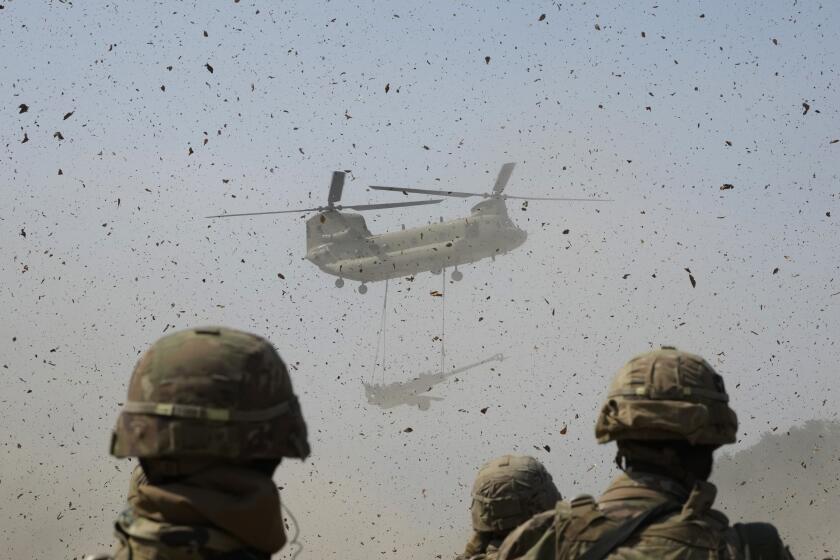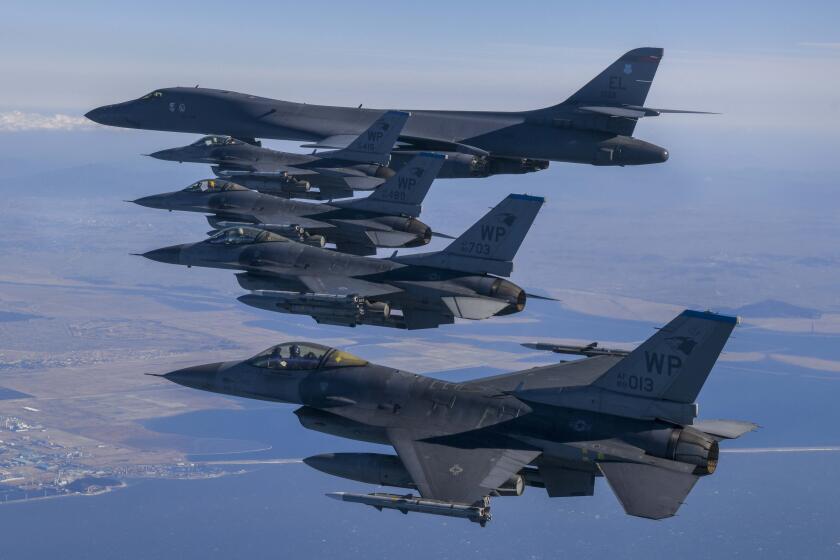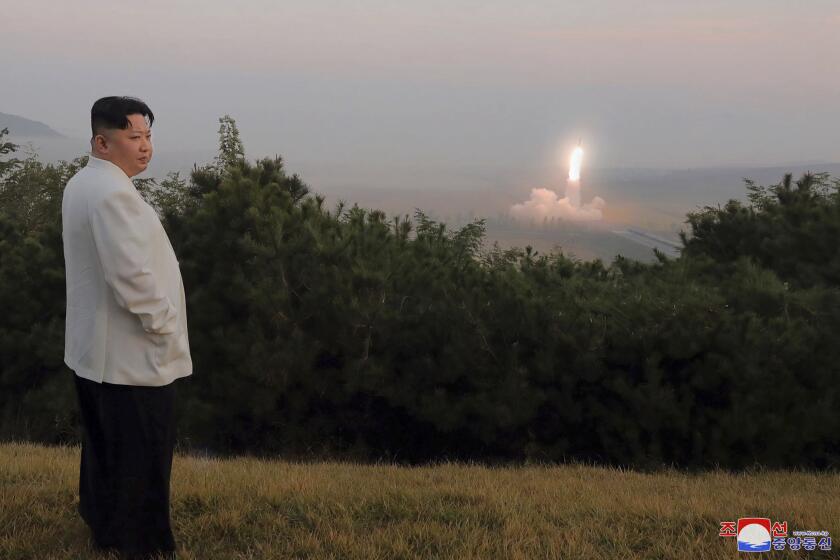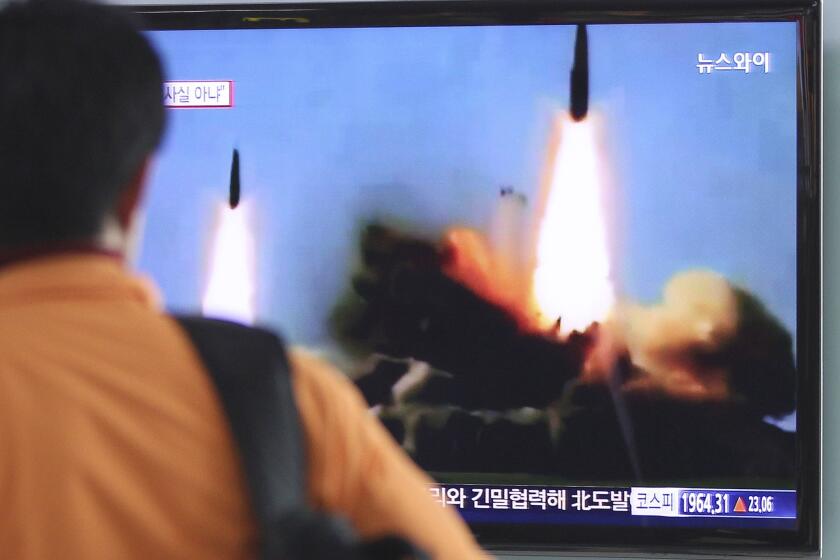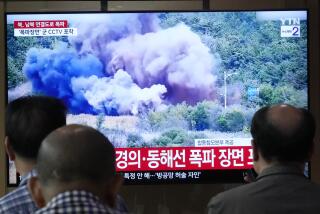North Korea fires missile that may have been a new type of weapon
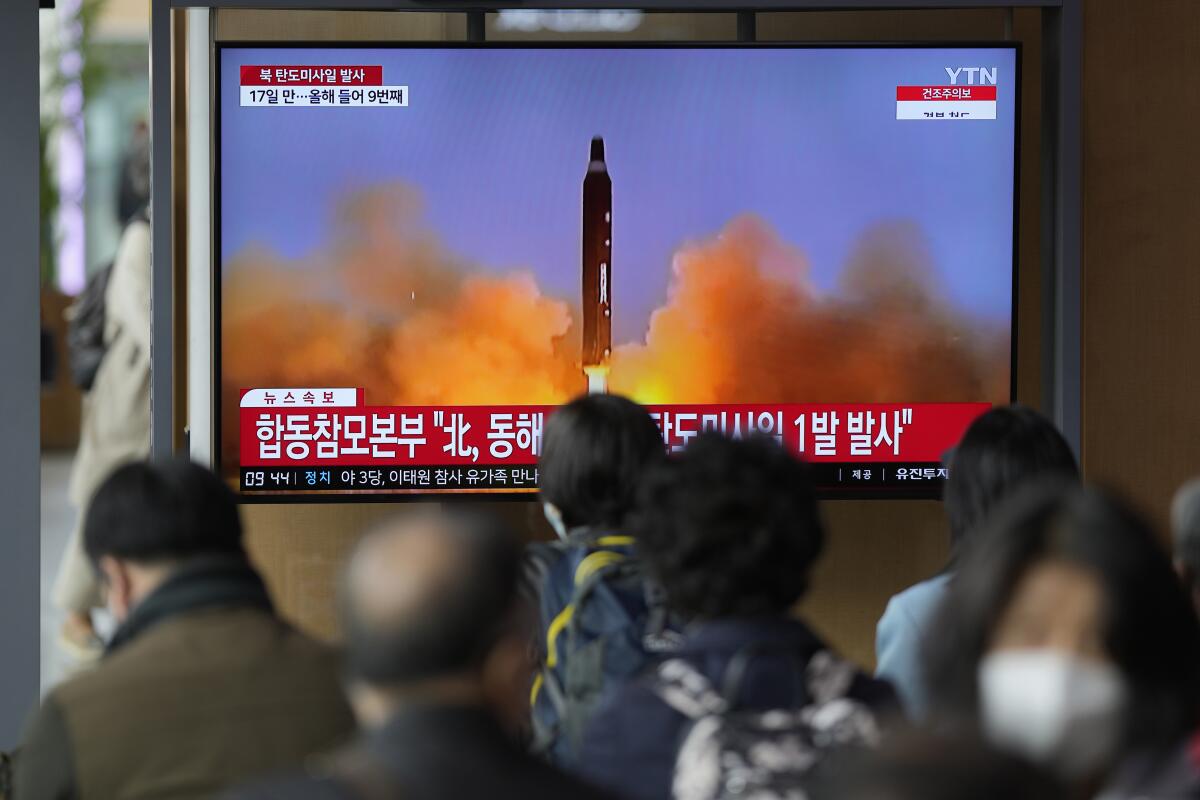
- Share via
SEOUL — North Korea launched a long-range missile on Thursday, possibly testing a new, more mobile, harder-to-detect weapon for the first time, its neighbors said, as it extends its provocative run of missile tests.
Japan briefly urged residents on a northern island to take shelter in an indication of its vigilance over North Korea’s evolving missile threats.
The missile was launched on a high angle from near the North Korean capital of Pyongyang and fell in the waters between the Korean peninsula and Japan after a 600-mile flight, South Korea’s Joint Chiefs of Staff said in a statement.
It described its range as medium or longer. The U.S. National Security Council called it a long-range missile and Japan’s government said it likely had an intercontinental range.
South Korea’s military believes North Korea launched a new type of ballistic missile, possibly using solid fuel, a defense official said on condition of anonymity because of office rules.
North Korea says its ballistic missile launch over the weekend simulated a nuclear attack against South Korea.
If the launch involved a solid-fuel intercontinental ballistic missile, it would be the North’s first test of such a weapon. North Korea’s known ICBMs all use liquid propellants that must be fueled before launches. The fuel in a solid-propellant weapon is already loaded, allowing it to be moved easier and fired faster.
A solid-fuel ICBM is one of the key high-tech weapons that North Korean leader Kim Jong Un has vowed to build to better cope with what he calls U.S. military threats. He also wants a multi-warhead missile, a nuclear-powered submarine, a hypersonic missile and a spy satellite.
Kim Dong-yub, a professor at the University of North Korean Studies in Seoul, said the launch may have involved a new intermediate- or long-range missile powered by solid propellants, or be related to North Korean preparation to launch a spy satellite.
U.S. National Security Council spokesperson Adrienne Watson said the latest launch “needlessly raises tensions and risks destabilizing the security situation in the region.”
Watson said the United States will take all necessary measures to ensure the security of U.S. territory and South Korean and Japanese allies.
During an emergency meeting of Seoul’s National Security Council, officials stressed the need to tighten three-way security cooperation with Washington and Tokyo. Japanese Prime Minister Fumio Kishida held a meeting of his security council to analyze the launch and Japan’s response.
The United States responded by flying long-range supersonic bombers in a show of force for joint exercises with South Korean and Japanese warplanes.
The nuclear envoys of Seoul, Washington and Tokyo held a call in which they called for a “decisive and united international response” to North Korean provocations and stronger efforts to stem illicit North Korean funding of its weapons program.
North Korea commonly test-launches missiles toward the international waters between the Korean peninsula and Japan, using elevated trajectories to avoid neighboring countries. South Korea and Japan typically don’t issue evacuation orders unless they determine the North Korean weapon is flying in their direction.
Japanese Defense Minister Yasukazu Hamada told reporters the North Korean missile launched Thursday did not reach Japan’s exclusive economic zone. But Japanese authorities still urged people on the northernmost island of Hokkaido to seek shelter and temporarily suspended train, bus and subway services there. Local communities also activated alert sirens, urging people to evacuate.
The government then retracted its missile alert, saying there was no possibility of the missile landing near Hokkaido. Chief Cabinet Secretary Hirokazu Matsuno told reporters the alert was based on the Japanese Defense Ministry’s early assessment of the missile’s path and was an “appropriate” step to prioritize people’s safety.
Japanese authorities issued a similar evacuation order in October when a North Korean intermediate-range missile flew over Japan in a launch that demonstrated the weapon’s potential to reach the U.S. Pacific territory of Guam.
North Korean leader Kim Jong Un signals more provocative tests to come after a series of missile launches designed to simulate use of nuclear weapons.
Thursday’s launch was the North’s first long-range missile firing since the country tested its longest-range, liquid-fueled Hwasong-17 ICBM on March 16. Kim Jong Un reviewed his country’s attack plans Monday and vowed to enhance his nuclear arsenal in more “practical and offensive” ways.
North Korea has launched about 100 missiles since the start of 2022, many nuclear-capable weapons that place the U.S. mainland, South Korea or Japan within striking distance.
The North’s testing spree is largely in protest of South Korean-U.S. military drills that it views as a rehearsal for an invasion. Some observers say North Korea uses its rivals’ drills as a pretext to modernize its weapons arsenal and pressure Washington and Seoul to make concessions such as the lifting of economic sanctions. South Korean and U.S. officials say their drills are defensive in nature and were arranged to respond to North Korea’s growing nuclear and missile threats.
Later Thursday, China, North Korea’s last major ally, reiterated its blame for the heightened animosities on the U.S. and South Korea.
“The negative impact of the U.S. military exercises and strategic weapons deployed around the peninsula a few days ago is obvious to all,” Foreign Ministry spokesperson Wang Wenbin said in a briefing.
SEOUL -- North Korea test-launched two medium-range ballistic missiles early Wednesday off its east coast in its longest-range launch since 2012, South Korea’s Yonhap News Agency reported, citing military sources.
North Korea unveiled a new type of nuclear warhead in late March, raising concerns it could conduct its first nuclear test in more than five years. Foreign experts debate whether North Korea has developed warheads small and light enough to fit on its more advanced missiles.
South Korean officials say North Korea has not been responding to South Korean calls on a set of cross-border inter-Korean hotlines for about a week. Communications on those channels are meant to prevent accidental clashes along the rivals’ disputed western sea boundary.
On Tuesday, South Korean Unification Minister Kwon Youngse expressed “strong regret” over what he called North Korea’s “unilateral and irresponsible attitude” over the hotlines.
North Korea’s advancing nuclear arsenal is expected to be a major topic at a summit between South Korean President Yoon Suk-yeol and President Biden this month in Washington.
Experts say the discussions between world leaders at Japan’s Group of 7 meetings in May could be crucial for maintaining diplomatic pressure on North Korea. U.N. Security Council permanent members China and Russia have blocked tighter sanctions on North Korea in recent months, underscoring a divide deepened by Russia’s war on Ukraine.
Yamaguchi reported from Tokyo.
More to Read
Sign up for Essential California
The most important California stories and recommendations in your inbox every morning.
You may occasionally receive promotional content from the Los Angeles Times.
